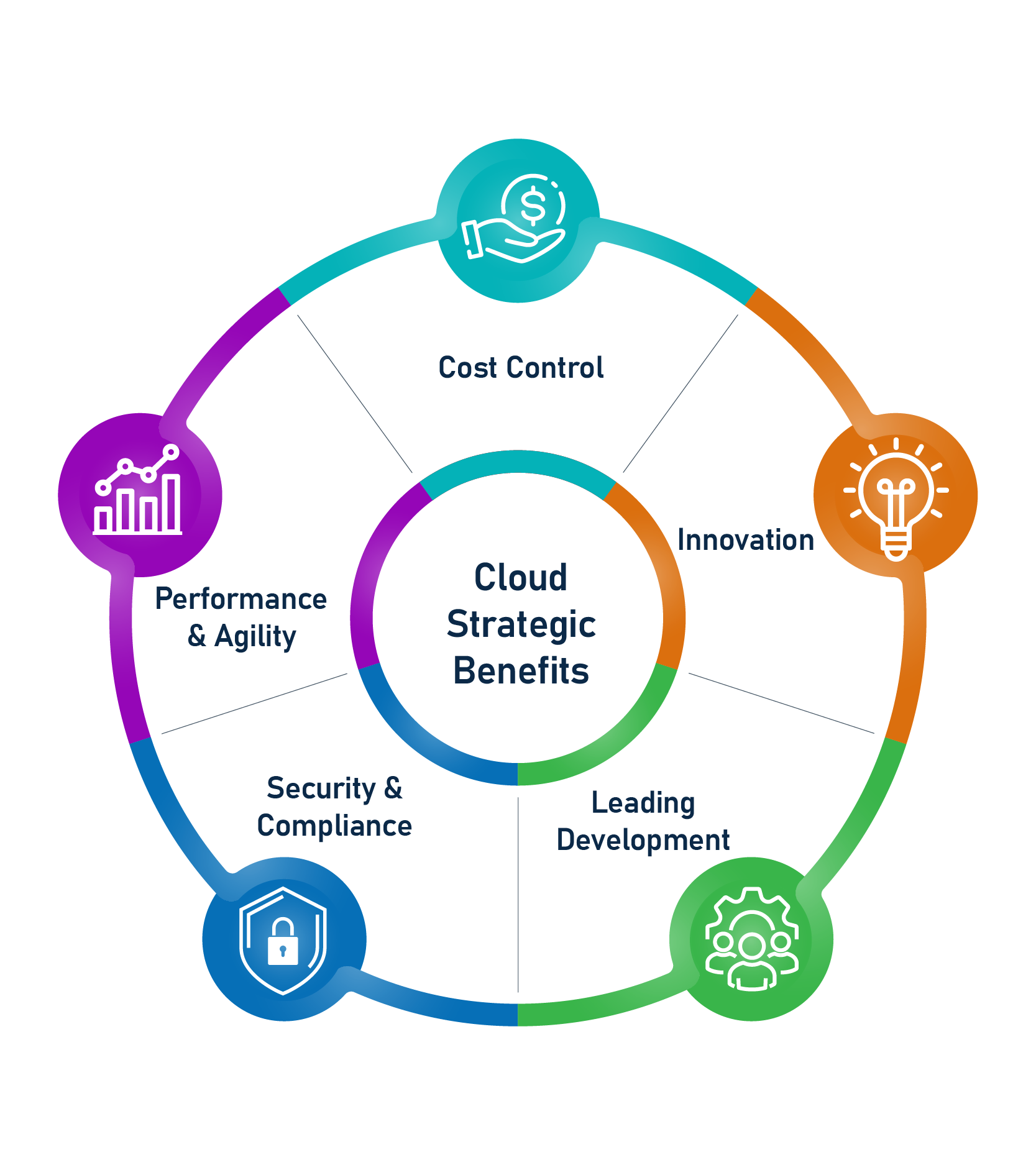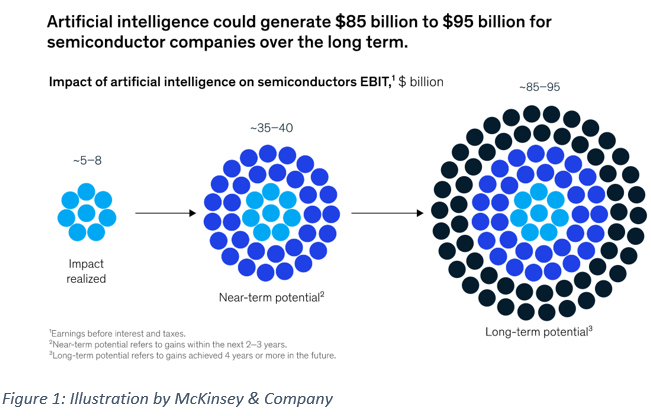Tech has been a driver of economic growth for decades. And it's not likely to let up anytime soon. The high-tech industry is characterized by rapid innovation that often results in market disruption and competitive prowess among players. High-tech firms enjoy healthy profit margins compared with their counterparts in other sectors primarily because of their R&D efforts. These firms develop products using cutting-edge technology in collaboration with leading industry manufacturers and research and development firms. While we touch upon what comprises high tech, this blog mainly outlines
We are entering a phase where high-performance computing will be used in every household. The semiconductor industry, part of high tech, will play an increasingly crucial role in enabling this high-performance computing and many other technological advances. Since the semiconductor industry is highly dependent on research and development, the strength of any enterprise is directly related to its ability to remain competitive. And this is precisely what we will watch closely in 2021 as chip technology becomes more powerful and complex - for both consumer and business applications.
According to an industry report, in the third quarter of 2020, the semiconductor market made $114bn, up 11.0% from the 2nd quarter of 2020, according to World Semiconductor Trade Statistics (WSTS). The 3Q20 growth was the highest since 11.6% in 3Q16.
Similarly, the rapid shift from local to online content, coupled with the proliferation of mobile devices and apps, has increased the need for a new generation of the delivery mechanisms for content. We're seeing consumers re-evaluate the value and convenience of packaged goods as they look for products that deliver content via social channels directly to their doors.
Technological innovation is hard to predict and often comes as a shock to our paradigm. We are witnessing a move in how businesses and industries are launching products and services, combining old tools with new strategies to improve results. This shift has implications for small business owners and prominent players in the industry as they embrace the new realities of working from home.
A bunch of forces will converge in the high-tech industry in 2021. Rapid innovation and the emphasis on getting stuff done have created a virtuous cycle where new products drive innovation, which causes more applications, business, and so forth. And it looks like we will see even more disruptive innovations at this point next year. 2021 is going to be important for high-tech companies: they'll either figure out how to stay relevant as the market shifts or be left behind as competitors forge ahead with new tactics.
From Artificial Intelligence to IoT, there's much to be excited about in tomorrow's tech. Realistically, it's hard to predict precisely what will come next—and whether current trends will continue or change. Without further ado…
Top High tech trends shaping the future
Cloud transformation: A fundamental re-thinking of how we approach data and business processes:
Cloud transformation is a term used to describe how organizations transform their IT infrastructure and application lifecycle to support the needs of their business customers. Cloud transformation requires a collaborative approach between different departments and business units within an organization to identify ways in which resources can be shared across boundaries more efficiently, and avenues for collaboration can be opened up to enable innovation faster. An operational approach to data and technology, cloud transformation enables organizations to transform their data and bring complex solutions to life in ways that would have taken months or years to build using traditional resources. It is about making information processing and sharing both frictionless and secure. Today's data supports the performance of complex business logic and enables new business opportunities while reducing costs and increasing sustainability, which becomes a top priority for all high tech businesses.

It can happen in many ways. Transformation starts with a shift in IT policy or business strategy. Each organization faces unique challenges as they transition to the cloud—critical modern practices such as open source, microservices, cloud data centers, and big data applications. High tech organizations must integrate new technologies into their systems to ensure continued value and reduced IT drift if they seek to stay competitive in the coming days.
Putting Customer First: The future is vision-driven and customer-centric:
Up until this point, companies have focused primarily on increasing revenue through growth in the bottom line. But customer experience is becoming increasingly relevant as companies seek to differentiate themselves through innovation, data, analytics, and real-time customer insight. It is not enough for businesses to out-innovate each other; they must also out-compete on customer experience.
CX processes such as onboarding a new customer, retention marketing, cross-selling, cross-channel marketing, and PPC advertising will become more sophisticated, emphasizing creating convenient, memorable customer experiences.
The positioning of product and service offerings is changing rapidly, as well as customers’ mindset toward services and brands. We're already seeing this with loyalty programs with a more interactive component and better measurement tools. This shift inevitably impacts how high tech companies market and deliver services.
There has been an explosion in customer experience marketing over the past five years. Increasingly companies are using data-driven and user-centered marketing approaches to achieve better CX results while also automating customer service. This trend will continue as high tech companies look towards AI for help with resistance to change efforts like onboarding new clients or ignoring technical underpinnings altogether.
AI for Software and Services: It is relatively unobtrusive, inexpensive, and scalable:
AI technology is only being deployed to solve some problems in some industries. Instead, it is being used to enhance existing solutions, provide new solutions when needed, and accelerate technology adoption in new domains. It is being used today by large companies to run ad campaigns that engage consumers on specific content across a broad range of search engines while simultaneously saving them time and money with the assistance of intelligent ad software.
A Gartner research indicates that over 70% of companies intend to deploy AI, and 14% have already implemented it in their business processes in some form.
Many AI-based solutions already have a foothold in industry-wide adoption. Even in retail, AI is being implemented to help optimize shelf life and inventory management. Many believe that AI will be reckoned with in 2021 for the high tech industry, creating advances in product design, marketing, customer engagement, and more.

High tech businesses are investing heavily in AI to improve not just their efficiency but also the efficiency of their suppliers' operations. AI-powered software provides a way for a company to do analytics without staff. The tech can conduct security checks, automate customer service, etc. Agencies are starting to experiment with the technology, with some seeing it as a way to cut costs or speed up service. And companies are thinking about how to use AI to reduce human error in customer service and increase security across their infrastructure.
Automation: Strengthening the workforce of the future, not replacing it:
Automated systems can perform more tasks and replace human workers in routine tasks when and if needed. This doesn't necessarily mean that software and software-based technology will replace human creative thinkers and problem solvers but rather could fall into the category of supporting creative output during times of limited human impulse control.
Workplace automation is critical in creating a more efficient and effective organizational structure. It allows businesses to delegate and responds more quickly to changing circumstances.
High tech businesses will see tremendous value added to work by automating routine and semi-routine tasks, helping clear space for human creativity and innovation, and speeding up business process operations. Technology is easily transferable from one place to another: the faster the technology, the quicker you can put it into place. Automation doesn't just mean programming computers to do work for you - although that's an important use of AI. It also means using software tools to create business value from textual information.
Digital Workplace: Bringing knowledge and collaboration more efficiently:
A digital workplace will enable new business models that cut costs, improve efficiency, and give employees more freedom.
The rise of shared workspaces, connected databases, professional interactives, and new social media platforms have created new possibilities for teams to collaborate and plan in ways that were never possible. Digital Workplace will continue to be one of the leading providers of virtual workspace solutions for organizations of all sizes looking to connect online or off.
Digital Workplace's mission is to change how organizations build and manage digital assets fundamentally. High tech and all businesses will experience a future where hybrid teams work alongside traditional teams and digital assets reside on-premises while creating value for both consumers and businesses.
Modernizing the High tech Supply Chain: Capitalizing on new efficiencies generated by the cloud
In recent years cloud SCM has become a big deal in the high tech supply chain - a trend that will continue. The basic idea is simple: instead of keeping track of where your stuff is physically located, manage it across multiple places using one centralized platform. It's about keeping track of transactional and delivery data from point A to point B without physically touching any items.
Yet many organizations are still struggling to realize the potential of cloud-based SCM—despite its widespread adoption—whereas the benefits far outweigh the costs for most companies. The benefits of cloud-based SCM extend beyond cost savings to increased innovation, engagement, and productivity—while also potentially expanding your business globally.
IoT: Driving the technology forward as an enabler
IoT is becoming a driving force for the high tech industry and the global economy as more and more things are being connected and operated using technology. Sensors and robots increasingly power the Internet of Things (IoT) and other systems that perform security, transportation, and energy management functions. This has resulted in both convenience and safety benefits and opportunities for new economic models. The IoT future will see many more interconnected devices and systems and ever more processing power for applications that require it.
IoT is being deployed at an accelerated pace across industries. Each new generation of connected devices relies on wireless networks as a backbone to reach its users. Every industry is looking for ways to manage and control the IoT data flowing through its systems. The high tech industry is driving this technology's growth, being providers and users.
Conclusion:
High tech companies need digital transformation. It involves continuous experimentation to improve business outcomes continuously. Innovation is the key to propelling a high tech business forward. It translates into new products, services, or business models. HIGH TECH INDUSTRY is experiencing explosive growth. The best technology companies are winning new customers by delivering services that were previously only available to large corporations.
The coming revolution in high tech business will be predominantly digital. The transformation will create millions of new opportunities and profound changes in how we live, work and interact with each other. Agile new entrants will disrupt entrenched industries. Innovation will come from all corners of the world and be fueled by inexpensive computers, the cloud, high bandwidth networks, and software as a service.
The world of high tech innovation is in constant change. Change means disruption, and every company, no matter how large or small, needs to be able to decide what shape its future will take.
The high tech industry is leading businesses worldwide into transformation and growth. However, as business models change, underlying IT applications need to adapt quickly to the new normal. They need a strategic roadmap and implementation services to fuel their growth and apply transformative technology. An agile technology partner with in-depth technical knowledge, accelerators, reference architectures, and proven methodology developed to cater to specific high tech needs can positively impact the organization.







